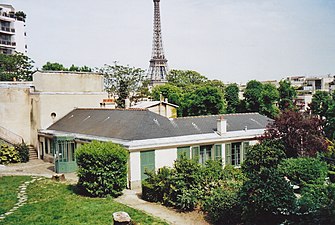Rue Raynouard
Coordinates: 48 ° 51 ' N , 2 ° 17' E
| Rue Raynouard | |
|---|---|
| location | |
| Arrondissement | 16. |
| quarter | Muette |
| Beginning | Place de Costa Rica |
| The End | 2, Place du Docteur Hayem |
| morphology | |
| length | 880 m |
| width | 14 m |
| history | |
| designation | 1867 |
| Original names | Rue Basse |
| Coding | |
| Paris | 8068 |
The Rue Raynouard is located in Passy , the 16th arrondissement of Paris .
location
The street is 880 meters long and stretches from Place de Costa Rica to Place du Docteur Hayem . It is a one-way street up to Avenue de Lamballle .
Name origin
The former Rue Basse owes its name to the French writer François Raynouard (1761–1836).
history
The Rue Raynouard is together with the Rue de Passy the oldest street of the former village Passy and connected the manor house ( French Demeure seigneuriale ), which is between the Rue des Vignes (Passy) and the Rue des Tombereaux ( Rue de l'Annonciation ) ( Auteuil ). Until the 17th century it was the most important connecting road and was first called "Grande Rue", then "Rue Haute", before it took on the name "Rue Basse" in the 18th century, which it kept until 1867 as today's Rue de Passy became the main street and was named "Grande Rue".
Passy's popularity in the 18th century attracted writers and artists. Large plots of land are being built along the road, Château de Boulainvilliers as the successor to Château de Passy, Hôtel de Valentinois (on the corner of today's Avenue du Colonel-Bonnet ). After the revolution, the old noble houses are poorly maintained, their parks are sold and divided.
Émile Zola describes the street, in which there are still many imposing buildings from the 18th century, as "very aristocratic, with magnificent palaces, brick stables, etc."
After Passy was incorporated by the law of June 16, 1859, the street was added to the Paris street network in 1863 and was given its current name in 1867.
Attractions
This street runs parallel to Rue Berton for a long time and is connected by the traditional viaduct network and a staircase.
- No. 16–20: Entrance to Square Raynouard , built by the architect Albert Vêque (1913)
- No. 19–21: Property belonging to the entrepreneur Benjamin Delessert (1773–1847), which reached as far as the Quai de Passy. On this site he built his first sugar beet factory at the beginning of the 19th century. In 1814 he already owned ten sugar beet factories in several places in France .
- No. 37: 9-storey building with a modern superstructure (1976) on an old structure; Architects: Raymond Ichbiah and Lionel Schein
- No. 40: Église Notre-Dame-de-Grâce de Passy , built in the 17th century, expanded in 1827 and restored in 1843.
- No. 42: Apartment of the chansonnier Pierre-Jean de Béranger between 1833 and 1835.
- No. 47: The Maison de Balzac , which is now a museum, is located on the property . The French writer Honoré de Balzac lived here between November 1840 and February 1847. For the chronic lack of money, the property had the advantage of having a separate rear exit to Rue Berton . Balzac used this to flee when his creditors appeared in front of the main entrance to his house on rue Raynouard.
- No. 50: Seat of the «Fédération française de Scrabble »
- No. 51–55: A building complex built by the architect Auguste Perret around 1930, which is still considered an architectural masterpiece. Perret himself spent the last 22 years of his life here and it is also the headquarters of the Union Internationale des Architectes .
- No. 64–70: At this point (corner of Rue Singer ) there was a pavilion of the Valentinois manor , in which Benjamin Franklin (1706–1790), one of the founding fathers of the United States , lived from 1777 to 1785., the poet and songwriter Pierre -Jean de Béranger (1780–1857) and the writer Alfred de Musset (1810–1857).
- No. 92: Villa Raynouard: The writer Julien Green lived in the private street from 1903 to 1906.
- Impressions from Rue Raynouard
Orientation
board on the corner of
Rue Singer
Web links
Individual evidence
- ↑ Auguste Doniol, "Notes sur les rues et avenues de Passy", Bulletin de la Société historique d'Auteuil et de Passy, March 31, 1900, p. 220 (French)
- ^ Henri Mitterand (editor): Émile Zola / France - Mosaic of a Society (Paul Zsolnay Verlag, Vienna / Darmstadt 1990), p. 49
- ^ Philippe Siguret / Bertrand Lemoine, Vie et historie du XVIe arrondissement , Editions Hervas, Paris, 1991, pp. 116f
- ↑ www.pss-archi.eu/ (French)
- ^ Jacques Hillairet , Dictionnaire historique des rues de Paris , Éditions de Minuit , septième édition, 1963, Vol. 2 ("LZ"), "Rue Raynouard", p. 324
- ^ "Béranger Pierre-Jean de" , www.parisrevolutionnaire.com .
- ^ Article by Marc Zitzmann in the Neue Zürcher Zeitung from January 20, 2006
- ^ Hôtel de Valentinois rue Raynouard / rue Singer Résidence de Benjamin Franklin
- ^ A b Philippe Siguret, Bertrand Lemoine : Vie et historie du XVIe arrondissement (Editions Hervas, Paris 1991), p. 108
- ^ Philippe Siguret / Bertrand Lemoine: Vie et historie du XVIe arrondissement (Editions Hervas, Paris 1991), p. 139
- ^ Julien Green, Journal , September 22, 1935.












